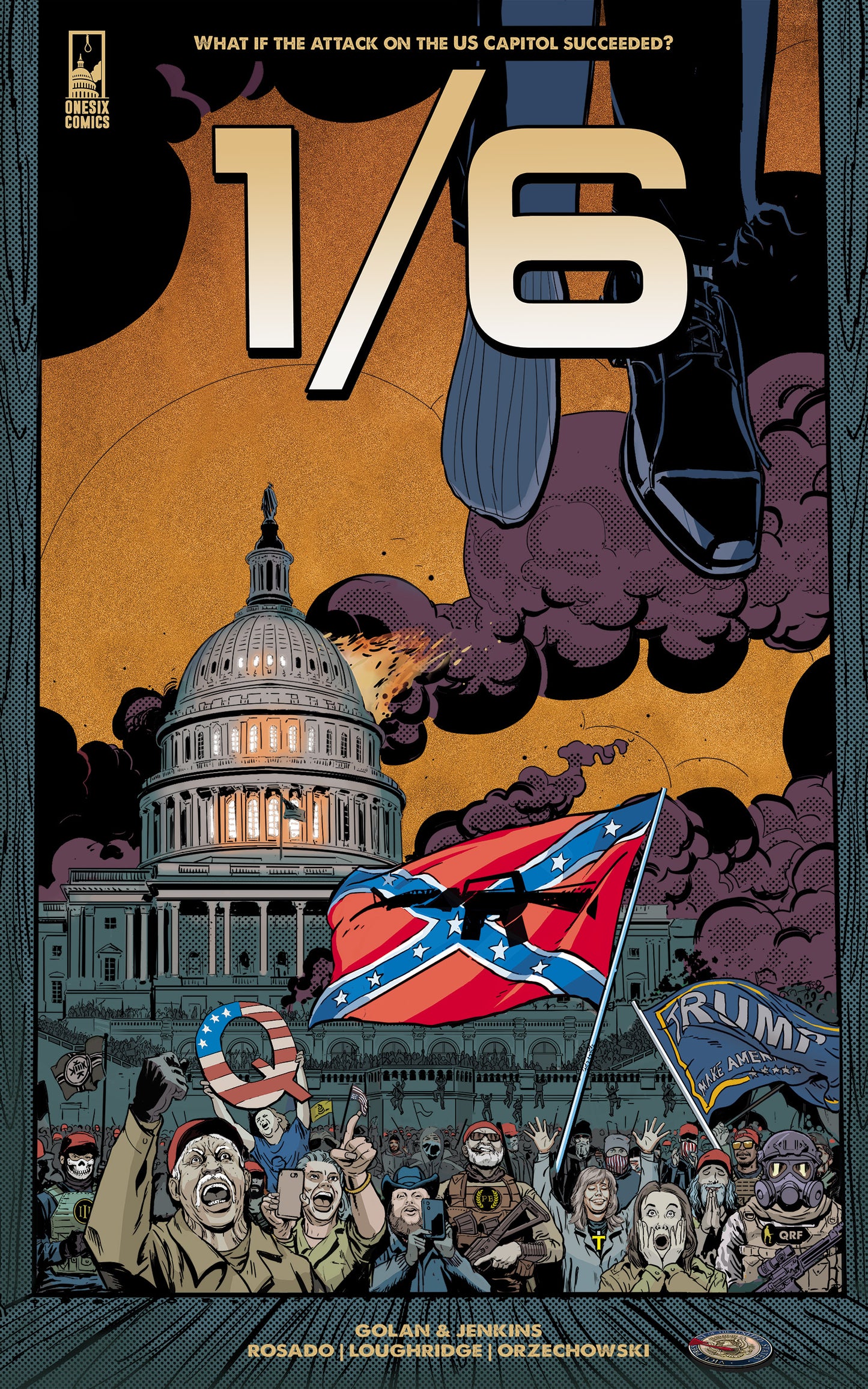 Alternate histories have captured watchers’ minds with shows like The Man in the High Castle and For All Mankind. With comics, it’s titles like Marvel’s What If?, or DC’s Elseworlds books. Fans are familiar with the concept of “the road not taken” and the comic mini-series 1/6: The Graphic Novel does that following the events of January 6th, 2021.
Alternate histories have captured watchers’ minds with shows like The Man in the High Castle and For All Mankind. With comics, it’s titles like Marvel’s What If?, or DC’s Elseworlds books. Fans are familiar with the concept of “the road not taken” and the comic mini-series 1/6: The Graphic Novel does that following the events of January 6th, 2021.
Created by writers Alan Jenkins and Gan Golan, and art by Will Rosado, 1/6 lets us look through the madhouse mirror of that day and see what could have happened if the insurrectionists had succeeded in their plot to overthrow democracy.
1/6 picks up after the attack on the capital and we’re shown a United States that has been subjugated to authoritarian rule. Law is enforced at gunpoint, the news is controlled by the super hard right government, and lives claimed on that day are blamed on the Black Lives Matter movement.
The hope of this book rests in the hands of an organized underground fighting for the truth of that day.
If you’re a person who can be triggered by themes of misinformation, white supremacy, or hate, this book is a warning about how close we came and how close we are to a dysfunctional society, but it’s also a guide to being prepared to avoid that world.
In early October I briefly chatted with two of the creatives behind 1/6, writer Jenkins and artist Rosado as they were signing copies of their book at Anyone Comics in Brooklyn NY.
George Carmona: What was the main goal for this comic book when you and Mr. Golan got together?
Alan Jenkins: I was waking up at four in the morning after the insurrection worrying about democracy. I’m a law professor, and I’m mostly teaching, but I’m a comic book head from way, way back. I wanted to do something about it to ring the alarm bells and call folks to action, and comic books seemed like the right vehicle to reach people who maybe didn’t have time to read the 800-page House Select Committee report or stay glued to CNN, but who love democracy, who love comics. So I called Gan, who is a New York Times bestselling graphic novelist, and he said “I’m in” and we were off. We were lucky enough to find Will and for him to agree to be part of the project.
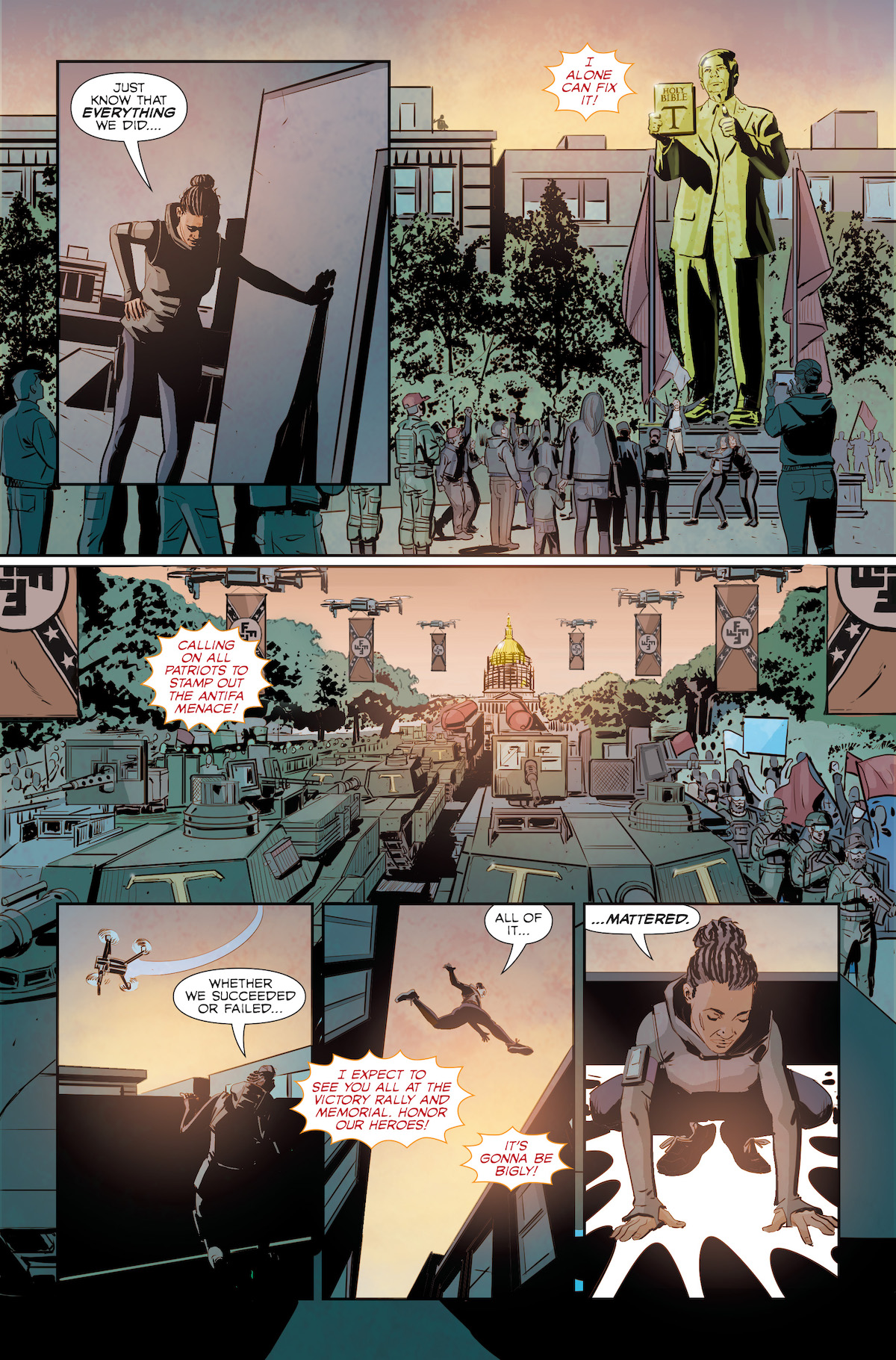
Carmona: We spoke briefly at New York Comic Con about media that explore alternate histories, this particular event being one of the most recent, what are some of the important divergences you want to resonate so people understand the danger of what could have happened?
Jenkins: 1/6 asks and answers the question what if the insurrection had been successful? The closer you look at the actual events of January 6, and the events leading up to it, you realize how close we came to losing our democracy. That very little would have had to change that day, if the mob turned right instead of left, which they do in our comic book. If President Trump had deputized the proud boys and the Oathkeepers like they were asking him to do and to declare martial law, we could have lost our democracy that day.
And I think importantly the threats are still with us. The authoritarianism, the anti-Semitism, and white supremacy, the things that led to January 6, are still here. 150 people in Congress who were election deniers, and Jim Jordan, who almost became Speaker was somebody who actively worked to undermine our democracy. The story is fictional, but it’s not far off from what actually happened and what could have happened.
But importantly, it’s also hopeful. It’s also rooted in characters. It’s not all gloom and doom. It is definitely fun and sometimes funny and it’s going to have a hopeful arc, I don’t want to spoil anything but it’s a very rich story.
Carmona: One of the things I appreciate about 1/6 is how the resistance is led by People of Color. That is a very significant thing because we talk about the American Revolution or the Civil War and it was just the white people that fought. You don’t hear about the other people who were out there doing the work that needed to be done.
Will, what was your take when they pitched the idea to you about doing this book?
Will Rosado: Well, it started with an email I received from Alan. A lot of times in this business as an artist, you get a lot of emails from people saying “Hey, I got a job for you” or “I’ve got this project, I’m looking for an artist to team up with.” I did some research on Alan and found that he’s a legit person in the world. Attorney, Professor, et cetera, and he was associated with Golan who I remember from his book, Unemployed Man. I had some other acquaintances in the business that were that worked on that project. So we arranged a Zoom to kind of hash out the idea, I understood the premise, and that it was going to be a heavy premise, right? It’s like, hey, here’s what could have happened especially if Officer Goodman didn’t do what he did.
Jenkins: This was the red pill. That’s why I’m dressed this way, I love The Matrix you know, it’s the red pill. It’s like, let’s deal with the truth of what happened and what could happen.
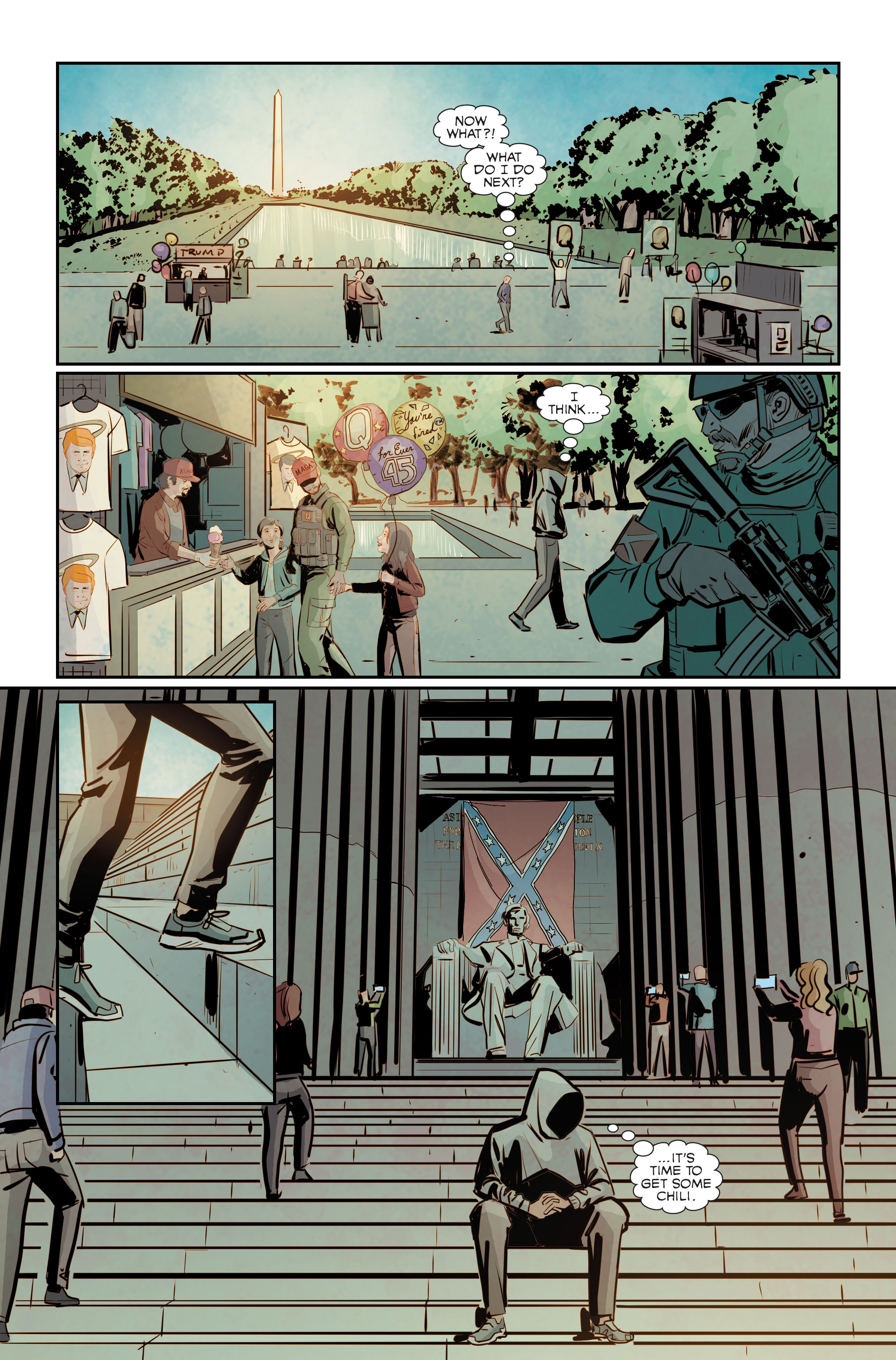
Carmona: This is a mini-series, so far, Book One is out now.
Jenkins: Book Two will be out in about three weeks. Okay. And, then, for us, part three will probably be out around January 6.
Carmona: That should be a fun date to remember. You spoke about the authenticity of the events, what resources did you use to research that day?
Jenkins: We interviewed dozens of journalists, experts, and others who either witnessed the events of January 6th firsthand or have studied it in the context of authoritarianism, hate groups, disinformation, or other threats to democracy. We also read indictments and other court documents, as well as the House Select Committee Report on January 6th, and other sources. I had two research assistants on the job as well, and they were indispensable in accurately describing the real events leading up to the Insurrection.
Carmona: What was the creative process of choosing historical points where things vector off?
Jenkins: Generally, we started by compiling almost everything in our notes, then winnowing down based on what would be clear, compelling, and understandable to a range of audiences. We know that only a few things would have had to change in order for the Insurrection to have been successful, and we focused on those moments in our storytelling. In addition to his amazing illustrations, Will was helpful in pointing out where we might be getting bogged down in the minutiae, and what to do about it. In the end, we wanted to tell an entertaining, if chilling, story about how close we came to losing our democracy that day and how we must remain vigilant to keep it safe.
One thing I do want to say, for comic book folks they know that this is part of a long tradition of comic books that are standing up for democracy and fighting autocracy. Captain America punched Hitler in the jaw in his first issue before the US went into World War Two. Wonder Woman fighting the patriarchy, Black Panther fighting the Klan, or Superman fighting the Klan. This is definitely part of that tradition and the alternate history is part of that tradition. Days of Future Past is an X-Men is an alternative version of Marvel canon history. It’s a dystopian reality with a lot of these same themes, I feel like 1/6 really fits well within this comic book tradition.
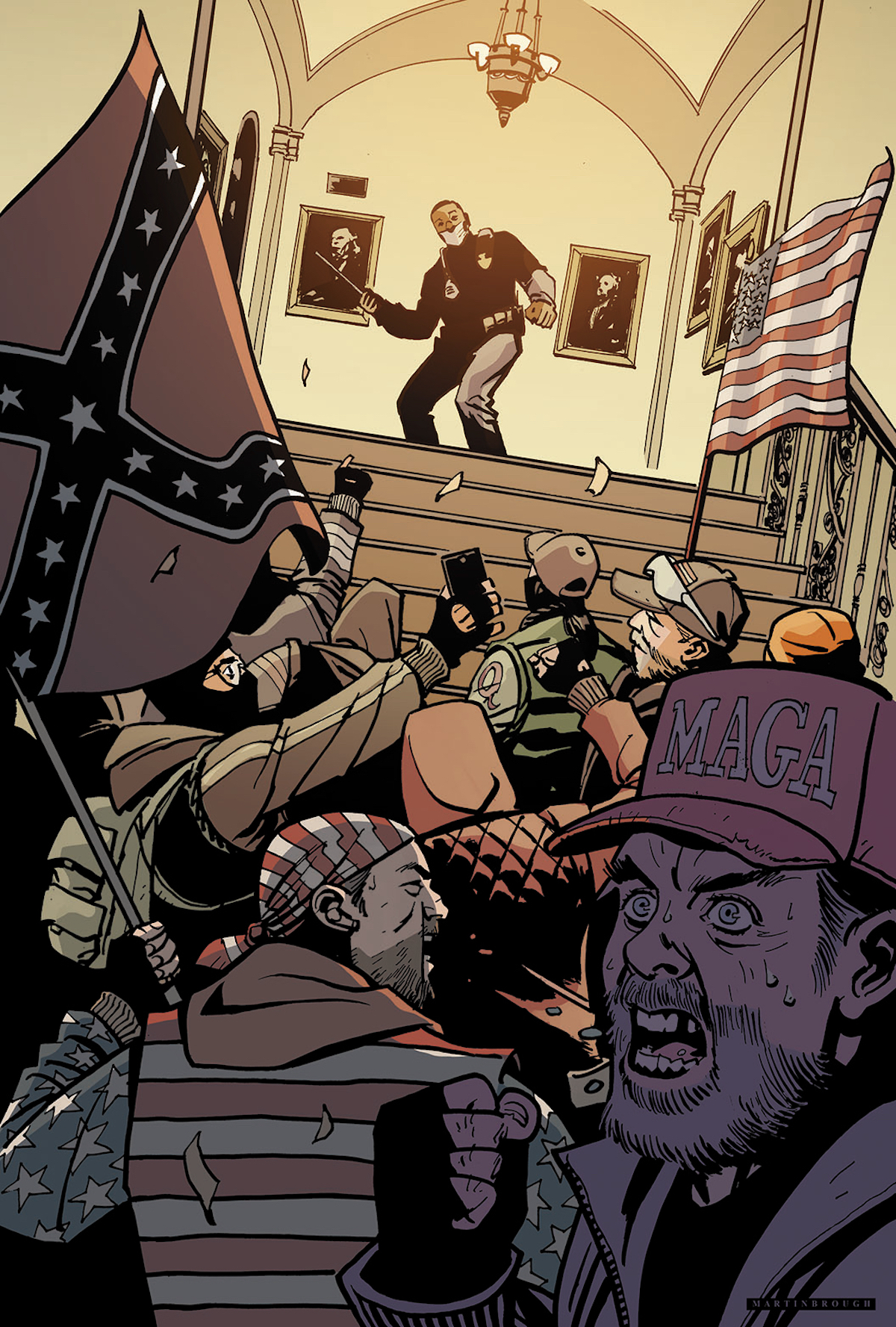
Carmona: Yeah, nerds all around can understand that, Star Trek is full of things like that too. Is there anything else you want to tell readers about the book to help them understand this alternate history and world that we live in that I want to say is very reminiscent of The Handmaid’s Tale with scaled-down personal rights.
Jenkins: A few things. One is, again, this is very close to reality. So the things that we see in the book that are repressive, they’re things that somebody in the maga-verse has proposed, at least, if not, so, for instance, you see drones all around. That’s real, you go to the US-Mexico border, there are drones policing the border, there’s drones being used for surveillance. So you know, those are real, the dystopian stuff in the book is actually just a tweak of reality.
There’s also some things that readers can do, if they read the book, and they get excited about it, there’s a QR code that they can scan. We’re doing a petition to disqualify insurrectionists from office with 60,000 signatures, and folks can hop on that there’s a free action guide. So you know, we want it to be an excellent story. I’m sure readers will find that the art is excellent by Will. And we want folks to be able to take action if the spirit moves. Please ask your local comic book store to stock it. Shout out to Anyone Comics, but you can also buy it on Amazon.



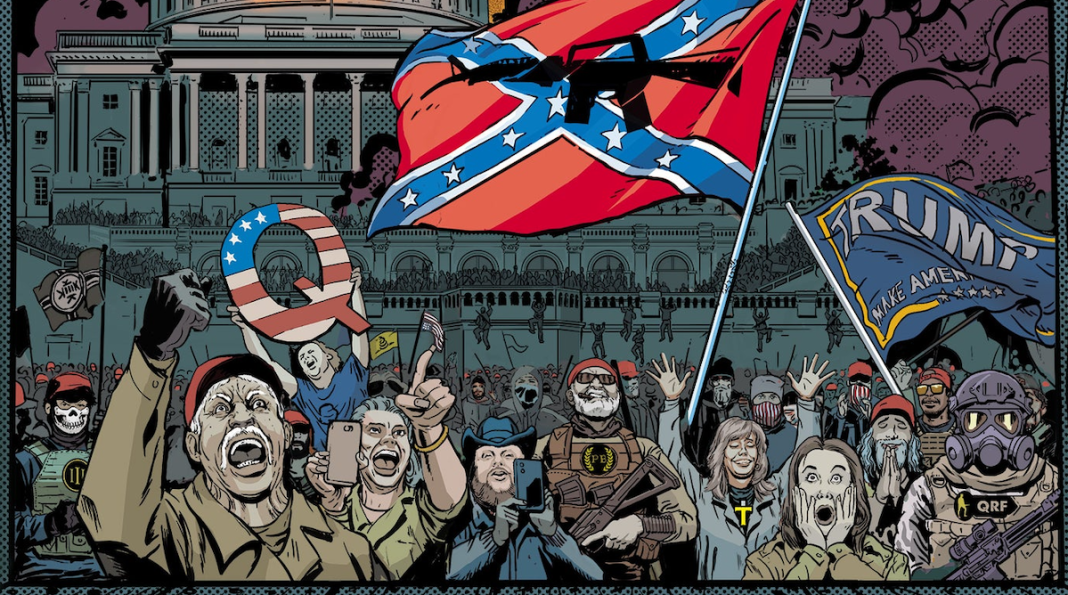
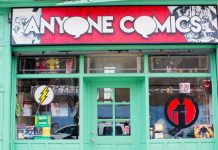
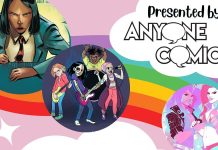
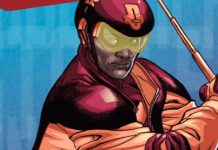





Nobody actually believes this nonsense, do they? A bunch of unorganized individuals believed the election was rigged, there was no “insurrection”. They were angry, they protested, and some of them trespassed (while others were lead in to the Capital by the guards). That’s all that happened, and making any more of this is pure fiction and propaganda.
Comments are closed.